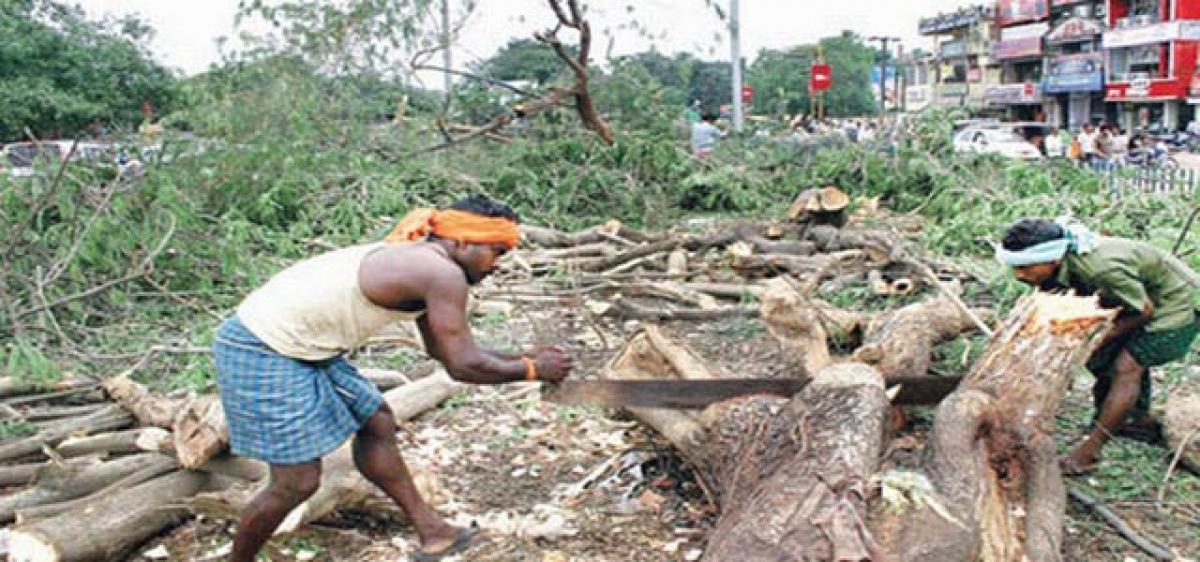Live
- NASA Tracks Five Giant Asteroids on Close Approach to Earth Today
- Pushpa 2 Hits ₹1000 Crore in 6 Days: How It Compares to Other Top Indian Films
- Vivo X200 and X200 Pro Launched in India: Price, Specifications, and Features
- Nitin Gadkari Admits Feeling Embarrassed at Global Summits Over Rising Road Accidents in India
- Comprehensive Review on Indiramma Housing Survey and Welfare Initiatives Conducted via Video Conference
- Jogulamba Temple Records Rs 1.06 Crore Hundi Revenue in 150 Days
- Opposition Slams ‘One Nation, One Election’ Bill as Anti-Democratic; BJP Allies Support the Move
- Celebrate Karthigai Maha Deepam Virtually with Sri Mandir’s LIVE Darshan Experience
- BJP Extends Support to Samagra Shiksha Abhiyan Employees' Strike, Demands Immediate Regularization and Welfare Benefits
- Dr. M. Priyanka Stresses Quality Education, Nutritious Meals, and Cleanliness in Schools
Just In

Reducing air pollution is an incredibly efficient way to improve the health of the people. In this the major hurdle is corruption and poor governance. As a major step, globally nations brought out vehicle technology and fuel technology.
The President of India and the Chief Justice of India at the National Green Tribunal’s two-day World Conference on Environment voiced concern for the protection of environment; Union Home Minister expressed that “pollution and climate change are adversely influencing our present and are also going to have a serious impact on our future” but on the contrary the Union Finance Minister and Attorney General of India voiced for development at the cost of the environment.
Reducing air pollution is an incredibly efficient way to improve the health of the people. In this the major hurdle is corruption and poor governance. As a major step, globally nations brought out vehicle technology and fuel technology. The vehicle user and fuel user pay the huge technology component by way of vehicle cost and fuel costs to provide cleaner air.
However, this is countered by several teething problems. For example:
*Use of vehicles not meeting fuel standard: From April 1, 2017 BS-IV comes in to force. Unfortunately, still around 8 lakh BS-III vehicles are with the manufacturers. Supreme Court of India has to decide the fate of these vehicles;
*Theft of parts from new vehicles by servicing centers: Service centres removing parts from the new and selling them in black market;
*Adulterated fuel sale: Kerosene is mixed with fuels – kerosene comes from the PDS. With the cost of fuel going up and up, this malpractice has risen several times;
*Burning of municipal & agricultural wastes: Municipalities openly burn solid waste. Due to sole crop system, stubbles of crops become unsuitable for animal fodder and thus farmers simply burn it; and
*Low Green Cover: At present in Hyderabad in GHMC area green cover is only around 5% and this may be further reduced with unplanned growth.
All these are clearly reflected in the increase in air pollution levels in Hyderabad.
I have been monitoring the pollution in twin cities of Hyderabad for the past two decades: with the fuel and vehicle technology the air pollution levels have came down drastically by 2003-05 but since then again it has been steeply rising. Prior to 1998, one vehicle used to produce air pollution equivalent to 10 vehicles released after 2000.
SO2 reduced from 18.6 in 1998 to 1.9 in 2003 and reached to 5.0 in 2006; the same in the case of NOx are 42.5 (2000), 20.1 & 25.5; in the case of RSPM they are 128 (1999). 73 (2004), 99 (2006); in the case of TSPM they are 287, 216 (2004), 261.
Now they crossed the levels which existed prior to 2000 except for SO2. RSPM, TSPM, NOx are very high at Abids, Punjagutta, Paradise & Charminar with low dispersion capacity; and very low at Zoo Park & KBR Park with good dispersion capacity of the ambient air.
In urban areas with concretization, with low green cover and increased levels of air pollution is creating urban-heat-island effect. This increased temperatures at ground level and as well at higher levels. This increased power consumption. Air pollution levels are generally high in winter. The dispersion of air pollutants depends upon the “mixing depth” – inversion layer height [increase of temperature with height] and wind. These limit the carrying out of air pollutants to longer distances.
In addition to these, poor and congested roads along with construction activity in congested GHMC areas are adding more dust and vehicle air pollution with reduced speed of vehicle movements. In twin cities, the new government is looking at building flyovers by butchering age-old trees instead of speedy completion of metro rail. Government is looking at number of plants planted but not survival rate. In order for ecological balance, we need around 33% of green cover. If we achieve this goal the air pollution levels will come down.
We may not reach such scenarios with Swachh India Programmes or by building green building concept or for that matter Smart Cities Mission or through adaptation of Paris agreement. This needs good governance and corruption free society. We have poor quality bureaucratic system. Politicians part of this system like congenital twins wherein corruption flourishes. (Writer former Chief Technical Advisor of World Meteorological Organization-WMO)
By Dr S Jeevananda Reddy

© 2024 Hyderabad Media House Limited/The Hans India. All rights reserved. Powered by hocalwire.com







